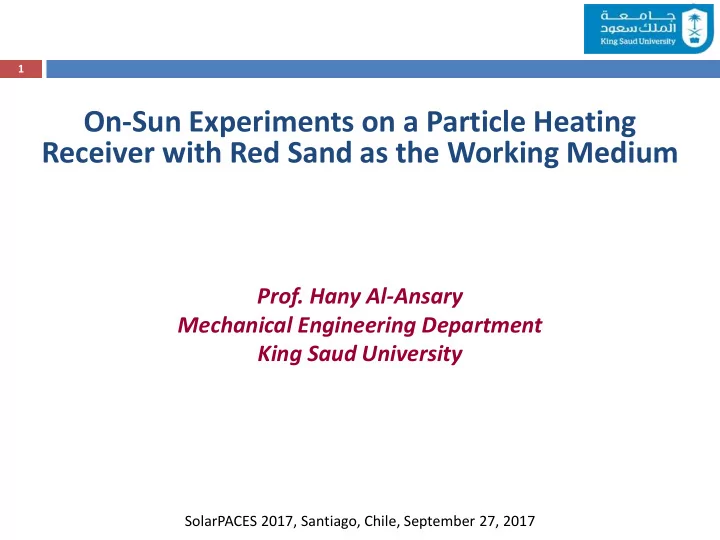

1 On-Sun Experiments on a Particle Heating Receiver with Red Sand as the Working Medium Prof. Hany Al-Ansary Mechanical Engineering Department King Saud University SolarPACES 2017, Santiago, Chile, September 27, 2017
Outline 2 What is a particle heating receiver (PHR)? Motivation and Objective Description of KSU PHR facility Experimental Methodology Sample Results Conclusion
What is a Particle Heating Receiver (PHR)? 3 A receiver in which particles (rather than molten salt or steam) are heated directly or indirectly Types of PHR Free-falling curtain Free-falling curtain with novel release patterns Obstructed flow Rotary kiln Centrifugal particle flow Tubular receiver with shell-side particle flow Particle-laden gas flow …
Obstructed Flow PHR 4 Design developed by KSU and GIT Particle flow is impeded by chevron obstructions Increases particle residence time and efficiency
Previous Tests of Obstructed Flow PHR 5 Tests conducted at Sandia National Labs Particulate material was Accucast ID50K (alumina-based) Results are encouraging (efficiency approaching 90%)
Challenges With Obstructed Flow PHR 6 Durability Suitability for high mass flow rate Cost of particulate material General concern with all PHR designs Current cost of engineered particles is $1-$2/kg
Motivation 7 Engineered particles are relatively expensive despite their superior optical properties When the material is also used for storage, the initial cost becomes considerable A “true” cavity receiver is less sensitive to the optical properties of the particulate material
Motivation 8 It is desirable to work with less expensive particulate materials that can achieve reasonable thermal efficiency Small efficiency penalty may be mitigated by the significantly lower cost Candidate materials: Red sand Spent catalysts Fly ash
Candidate Particulate Materials 9 Red sand is particularly promising Abundant and very inexpensive ($0.01-$0.02/kg) No sintering at temperatures as high as 1000°C Depending on source, it can be relatively dark and round Stock Photo SENER
Objective 10 To assess the thermal efficiency of an obstructed flow PHR using red sand as the particulate material
KSU’s 300 kWth Test Facility 11 To meet the study’s objective, the 300 kWth PHR test facility at KSU was utilized.
Experimental Setup 12
Experimental Methodology 13 Rate of thermal energy absorption is calculated from the energy equation: 𝑅 = 𝑛 × 𝐷 𝑞 × 𝑈 out − 𝑈 in Flow rate is controlled by varying the speed of the particle conveyor Temperature is measured by 3 thermocouples at the inlet and outlet Specific heat of sand at different temperatures is found from the literature
Sample Results 14 Direct Normal Irradiance on August 2, 2017
Sample Results 15 August 2, 2017 Flow rate: ≈ 1.2 kg/s
Sample Results 16 August 2, 2017 Flow rate: ≈ 1.2 kg/s
Sample Results 17 No flux measurement tools were available to directly measure incident thermal power on the receiver SolTRACE was run with actual DNI data and some realistic field parameters • Constitutes and upper limit on incident thermal power
Sample Results 18 These are lower limits due to some idealized SolTRACE parameters and exclusion of the thermal capacity term of the energy equation
Effective vs. Fixed Bed Absorptance 19 With receiver efficiency being in the range of 60% to 70% (considering radiative and convective losses), the effective red sand absorptance is at least 70% Lab measurements of a fixed bed of red sand shows an absorptance of about 55% The difference is due to particle-to-particle interaction across the depth of the actual curtain flow • Fixed bed optical properties can be negatively misleading
Conclusions 20 Preliminary results show that an obstructed flow PHR with red sand has an efficiency of at least 60%-70% at temperatures up to 450°C Effective absorptance of red sand is significantly higher than fixed bed asborptance A prolonged test campaign is needed to strengthen these conclusions With a cavity receiver, red sand would become an even more attractive option LCOE analysis is needed to assess whether the relatively small drop in efficiency by using red sand is mitigated or surpassed by the reduction in initial cost
Acknowledgments 21 Funding from the Saudi Electricity Company made this research possible. It is truly appreciated
Acknowledgments – Co-Authors 22 King Saud University Dr. Abdelrahman El-Leathy Mr. Talha Shafiq Mr. Eldwin Djajadiwinata Dr. Syed Danish Mr. Shaker Alaqel Dr. Zeyad Al-Suhaibani Mr. Rajed Saad
Acknowledgments – Co-Authors 23 Georgia Institute of Technology Dr. Sheldon Jeter Mr. Matthew Golob Mr. Clayton Nguyen Dr. Said Abdel-Khalik
Acknowledgments – Co-Authors 24 Saudi Electricity Company Dr. Nazih Abu-Shaikhah Eng. Mohamed Haq Eng. Ahmed Al-Balawi Eng. Fahad Al-Harthi
Thank You Hany Al-Ansary hansary@ksu.edu.sa
Recommend
More recommend